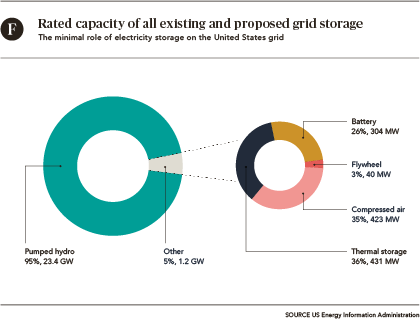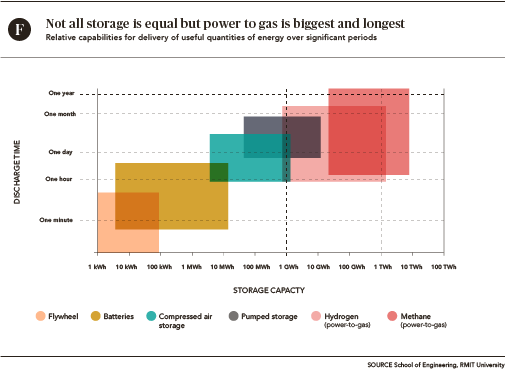TYPES OF STORAGE
There is no universally exploitable, affordable and proven method for storing large volumes of electricity
….
Most storage technologies in use today have been playing a part in electricity supply for a number years, though only pumped hydro has been deployed at any significant scale (see a table of types, capabilities and principle uses here). The lack of investment in storage is a reflection of the forces of supply and demand, which indicate a limited need for the product, evident in its low market price. The services storage offers are often already provided from supplies of electricity as it is generated and at less cost, also on power systems with high proportions of renewable energy.
All types of storage yet developed are constrained by technical and economic limitations on their use. In principle, however, each technology can contribute to meeting a number of power system requirements.
..
..
PUMPED STORAGE
As the only storage technology capable of storing large amounts of electricity, pumped hydro is widely deployed. It is proven and reliable and comes at a cost that makes it suitable for several applications. Lack of suitable sites for reservoirs, however, limit its global expansion. Around the world, pumped hydro capacity amounts to well under half the volume of wind capacity alone.
Pumped hydro requires two reservoirs, one at an upper level, the second at a lower level. The difference in height influences the power output and the volume of the reservoirs influences the time for which the installation can operate. One of the world’s best examples of a pumped hydro facility is at Dinorwig in the UK. It has six 300 MW water turbines that can provide power for up to six hours. Full load output can be achieved in about 75 seconds from standstill. That speed of response means that pumped hydro is well suited to numerous applications.
The largest installation in the world is in the United States and has a capacity of 3000 MW. More large facilities are under construction, particularly in China.
..
..
COMPRESSED AIR
Compressed air energy storage (CAES) requires a large, sealed space to contain air which is compressed, thus absorbing power, and then released, often through a combined cycle gas turbine, when power is required. Abandoned mines could provide locations for CAES in addition to salt caverns.
Significant amounts of heat are generated when the air is compressed and that has to be dealt with, adding to the cost. The heat can be stored as hot water, or in another heat storage medium and converted back to electricity through a steam turbine. Energy is also needed to reheat the cold air released from the store.
The round-trip efficiency of CAES is in the region of 65-70%, meaning 30-35% of the energy is lost during the process. The output of the facilities that have been constructed is modest, mostly in the range tens of megawatts to around 300 MW. Across the United States, CAES has a combined capacity of 600 MW out of a reported world total of 2600 MW.
The complexities of the process and its cost have prevented CAES from making any significant market breakthrough, despite considerable government expenditure over time and dollops of venture capital still being spent on the concept.
..  ..
..
BATTERIES
The principal advantage of batteries over other storage technologies is their rapid response time, which is virtually instantaneous. They can provide grid support services faster than other storage technologies and potentially faster than generation supplied directly from the grid. The principal disadvantage of batteries is their large size at grid scale and their weight, which has made lowering their cost through reduction of material a major challenge.
..
Lithium-ion: Of the various types of battery, Lithium-ion batteries account for the biggest contribution for grid scale storage applications by a large margin, with a combined 400 MW installed globally, about 14% of the total grid storage battery capacity. Other batteries offer more stability and longer duration, but lithium-ion beats them on price and simplicity, dominating the grid-scale battery market as a result.
..
Nickel cadmium: The commissioning of a more conventional battery type, a 40 MW nickel cadmium battery in Alaska in 2003 attracted much attention, but it can only sustain its output for seven minutes. The local utility regards battery backup as “an economic and ecological alternative to spinning reserve” and it also stabilises the local grid. The project may still rank as the world’s most powerful battery, but the claim for the largest battery, in energy terms, is now made for a lithium-ion project in California with capacity to store 80 MWh — enough to power eight average American homes for a year — and a power output of 20 MW.
..
Flow batteries: For the past three decades flow batteries have held tantalising promise and a number of grid scale demonstration projects have come and gone. The largest have capacities around 1 MW and storage capacities around 4 MWh. A flow battery stores energy in tanks of liquid chemicals and the larger the tank the larger the store. When charging, a chemical reaction occurs and the liquid flows to a tank for charged chemical. Spent or discharged chemical is held in a separate tank.
The challenges lie in dealing with the harmful chemicals, the degradation of the battery’s capabilities over time resulting from charge and discharge cycles, and the need for periodic maintenance to restore their capacity. Development work is ongoing into new non-corrosive chemical solutions that can hold a charge for longer than lithium-ion and enable flow batteries to be built from cheaper materials.
..
Electric vehicles: The steady transition to electric vehicles potentially provides a virtual battery store already paid for, though of relatively modest size compared with non-battery storage technologies. Batteries designed for vehicles, however, are not well suited for use as two-way power stores, as Tesla’s Elon Musk has pointed out. They can nonetheless add additional flexibility to grid operation if encouraged to charge in off-peak periods using time-of-use pricing.
..
A commercial opportunity exists for demand side aggregators to sell “negative load” to the grid from vehicle batteries by paying their owners to shift charging times on request. Aggregators could also potentially sell stored electricity in vehicles to the grid. Even if that should become technically possible and affordable, drawing power from large numbers of parked and charged vehicles and selling it back into the system is a logistical challenge of serious magnitude if the owners are not to be inconvenienced.
..  ..
..
HEAT STORAGE
Traditionally, heat storage of electricity has not been reversible. Night storage heaters typify one-way storage technology, aiding power system management by reducing the difference between daytime and night time demand. As a result, less generating capacity is required, a saving for consumers. Electric space and water heating is generally more expensive than gas or oil-fired heating, but transitioning to more electric heating could provide a large source of one-way storage and inexpensive demand-side management. As a passive one-way store, electric water heating can be modulated without significantly affecting the comfort of the consumer as can space heating, though to a lesser extent.
Two-way heat storage that can act as a sink for surplus wind and solar, with conversion of the heat back to electricity, is possible, but with a severe efficiency penalty. Siemens is developing a heat-based storage technology with the Technical University of Hamburg and local utility Hamburg Energie. Electricity is used to heat an assembly of rock-fill about the size of a football pitch and with an insulated cover. A steam turbine converts the heat energy back to electricity.
The capacity of the experimental store is 36 MWh and it can deliver 1.5 MW for 24 hours, enough for the annual needs of ten European households. The overall efficiency of the pilot system is estimated to be 25%, with expectations of increasing it to around 50% in future.
Combined heat and power (CHP) systems also provide storage for surplus electricity, diverting it to heat water in giant centralised holding tanks. The Studstrup facility in Denmark, one of the world’s largest biomass power stations, incorporates a giant squat storage tower that holds about 30,000 cubic metres of hot water.
In countries without well developed district heating networks, large scale heat storage requires further development of effective latent heat or thermochemical systems, as the UK Energy Research Centre recently concluded. The storage volumes required would otherwise be too large and difficult to integrate into existing domestic dwellings. Thermochemical systems use materials such as calcium hydroxide, which changes into calcium oxide and water on heating, in a reaction which is reversible. Continual upgrades of existing CHP facilities, where they exist, is a more readily available storage option.
..
Converting power to gas as a
storage medium is a technique long under
development, but short on realisation and
with uncertain cost
..
POWER TO GAS
Converting power to gas as a storage medium is a technique long under development, but short on realisation and with uncertain cost. Most proposals convert surplus electricity through electrolysis to produce hydrogen as a fuel for road transport or for injection into the natural gas grid. Another possibility is to combine the hydrogen with carbon dioxide and produce methane.
These various conversion processes bring with them an efficiency penalty and further efficiency losses are incurred if the gas is to be converted back into electricity. Not all the proposed uses of hydrogen or methane necessarily involve conversion back into electricity. One recent analysis by Germany’s Karlsruhe Institute of Technology concluded: “Power-to-Gas (PtG) might play an important role in the future energy system. However, technical and economic barriers have to be solved before PtG can be commercially successful.” •
..__TEXT Lyn Harrison & David Milborrow
This article is part four of our five-part special report on grid-scale electricity storage. Find parts one-five linked below or get the key takeaways at a glance